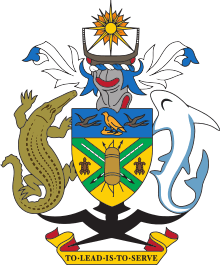Solomon Islands general election, 1964
 |
| This article is part of a series on the politics and government of Solomon Islands |
|
|
Politics portal |
General elections were held in the Solomon Islands for the first time in 1964.
Background
In 1960 a Legislative Council was established composed entirely of appointed members. Of the 21, only six were Solomon Islanders. Following a White Paper in 1963, the British Privy Council approved a new constitution for the British Solomon Islands on 25 September 1964, replacing the 1960 constitution. On 4 November the British Solomon Islands Order was passed by the Parliament of the United Kingdom, bringing into force section 31, which related to the holding of elections prior to the rest of the constitution coming into effect on 1 February 1965.[1]
Electoral system
The new constitution provided for a 25-seat Legislative Council, with 17 appointed members (15 official and two unofficial) and eight elected members. Of the elected members, three represented Malaita, two represented Central District, whilst Eastern District, Western District and Honiara had one member each.[1]
Although the Honiara representative was directly elected by universal suffrage (with the voting age set at 21), the remaining seven members were elected by electoral colleges. The colleges were composed of elected local councillors, with one member per 500 residents of the constituency. Where the number of elected councillors was insufficient, councillors could elect further members by secret ballot. The colleges then elected the members of the Legislative Council; preliminary ballots were used to eliminate the lowest-scoring candidate until only two remained, at which point the candidate with a majority of votes was elected.[1]
Results
Eric Lawson was elected in Honiara.[2]
References
- ↑ 1.0 1.1 1.2 Decolonising the Solomon Islands: British theory and Melanesian practice Alfred Deakin Research Institute
- ↑ Roland Rich, Luke Hambly & Michael G Morgan (2008) Political Parties in the Pacific Islands, ANU E Press, p106
| ||||||||||